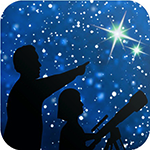September skies bring the lovely Summer Triangle asterism into prime position after nightfall for observers in the Northern Hemisphere. Its position high in the sky may make it difficult for some to observe its member stars comfortably, since looking straight up while standing can be hard on one’s neck! While that isn’t much of a problem for those that just want to quickly spot its brightest stars and member constellations, this difficulty can prevent folks from seeing some of the lesser known and dimmer star patterns scattered around its informal borders. The solution? Lie down on the ground with a comfortable blanket or mat, or grab a lawn or gravity chair and sit luxuriously while facing up. You’ll quickly spot the major constellations about the Summer Triangle’s three corner stars: Lyra with bright star Vega, Cygnus with brilliant star Deneb, and Aquila with its blazing star, Altair. As you get comfortable and your eyes adjust, you’ll soon find yourself able to spot a few constellations hidden in plain sight in the region around the Summer Triangle: Vulpecula the Fox, Sagitta the Arrow, and Delphinus the Dolphin! You could call these the Summer Triangle’s “hidden treasures” – and they are hidden in plain sight for those that know where to look!
Author Archives: wpadmin
Artemis 1: A Trip Around the Moon – and Back!
We are returning to the Moon – and beyond! Later this summer, NASA’s Artemis 1 mission will launch the first uncrewed flight test of both the Space Launch System (SLS) and Orion spacecraft on a multi-week mission. Orion will journey thousands of miles beyond the Moon, briefly entering a retrograde lunar orbit before heading back to a splashdown on Earth.
Find Hercules and His Mighty Globular Clusters
Hercules is one of the standout heroes of Greek mythology, but his namesake constellation can be surprisingly hard to find – despite being one of the largest star patterns in our night skies! Once you find the stars of Hercules, look deeper; barely hidden in the space around his massive limbs and “Keystone” asterism are two beautiful globular star clusters: M13 and M92!
Solstice Shadows
Solstices mark the changing of seasons, occur twice a year, and feature the year’s shortest and longest daylight hours – depending on your hemisphere. These extremes in the length of day and night make solstice days more noticeable to many observers than the subtle equality of day and night experienced during equinoxes. Solstices were some of our earliest astronomical observations, celebrated throughout history via many summer and winter celebrations.
Night Lights: Aurora, Noctilucent Clouds, and the Zodiacal Light
Have you spotted any “night lights”? These phenomena brighten dark skies with celestial light ranging from mild to dazzling: the subtle light pyramid of the zodiacal light, the eerie twilight glow of noctilucent clouds, and most famous of all, the wildly unpredictable and mesmerizing aurora.
Springtime Catspotting: Lynx and Leo Minor
Many constellations are bright, big, and fairly easy to spot. Others can be surprisingly small and faint, but with practice even these challenging star patterns become easier to discern. A couple of fun fainter constellations can be found in between the brighter stars of Ursa Major, Leo, and Gemini: Lynx and Leo Minor, two wild cats hunting among the menagerie of animal-themed northern star patterns!
Embracing the Equinox
Depending on your locale, equinoxes can be seen as harbingers of longer nights and gloomy weather, or promising beacons of nicer temperatures and more sunlight. Observing and predicting equinoxes is one of the earliest skills in humanity’s astronomical toolkit. Many ancient observatories around the world observed equinoxes along with the more pronounced solstices. These days, you don’t need your own observatory to know when an equinox occurs, since you’ll see it marked on your calendar twice a year! The word “equinox” originates from Latin, and translates to equal (equi-) night (-nox). But what exactly is an equinox?
Hang Out with the Twins of Gemini
The night skies of February are filled with beautiful star patterns, and so this month we take a closer look at another famous constellation, now rising high in the east after sunset: Gemini, the Twins!
Hunting the Hunter: Observing Orion
If you are outside on a clear January night, it’s hard not to notice one distinctive star pattern above all: Orion! While we’ve covered Orion in earlier articles, we’ve never discussed observing the constellation as a whole. Perhaps you’ve received a new telescope, camera, or binoculars, and are eager to test it out. Orion, being large, prominent, and full of interesting, bright objects, is a perfect constellation to test out your new equipment and practice your observing skills – for beginners and seasoned stargazers alike.
The James Webb Space Telescope: Ready for Launch!
NASA’s James Webb Space Telescope is ready for lift-off! As of this writing (November 15), the much-anticipated next-generation space telescope is being carefully prepared for launch on December 18, 2021, and will begin its mission to investigate some of the deepest mysteries of our universe.

